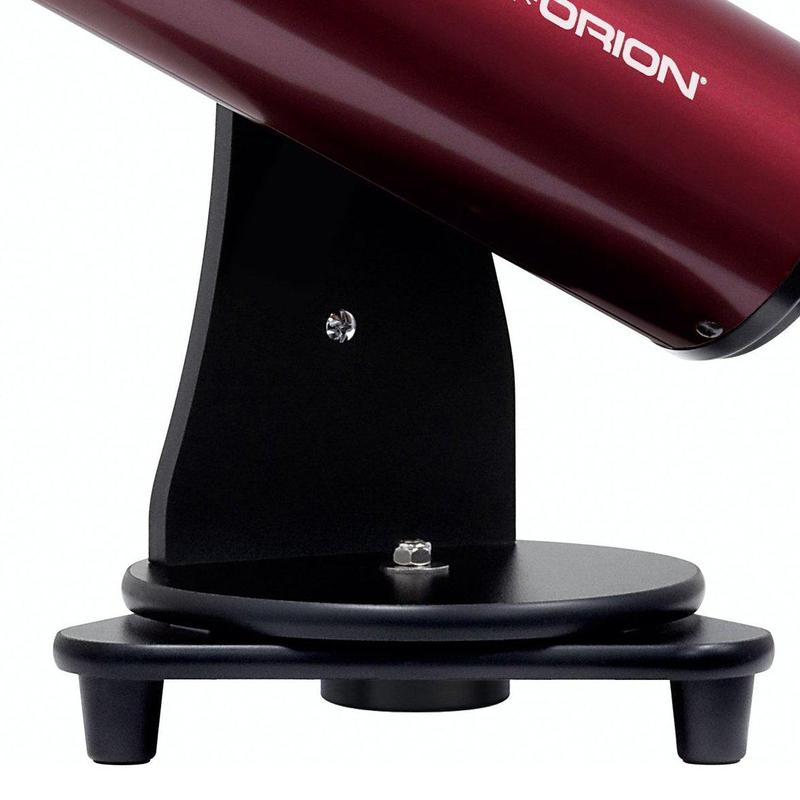
A small 3/8"-to-1/4"-20 bushing is also included if you wish to attach the SkyScanner to a tripod featuring a 1/4"-20 threaded post. There is a threaded socket on the bottom of the telescope's base so it can be coupled to a field tripod equipped with a 3/8" threaded post. If there isn't a table nearby when you want to use the SkyScanner 100mm TableTop Reflector telescope, you can easily attach its wooden altazimuth base to a field tripod. Once aligned with the telescope, just turn on the EZ Finder II and peer through the sight's small circular viewing window so you see the red dot, and move the telescope until the red dot is on the object you want to see to place it in the reflector's field of view.

The included Orion EZ Finder II red-dot sight makes it "EZ" to aim the telescope.įollowing a simple alignment procedure that parents can help with, you can use the EZ Finder II sight to accurately aim the SkyScanner 100mm TableTop telescope at objects in the sky like the Moon and bright planets.
#Orion skyscanner 100 reflector portable
More experienced amateur astronomers can use the easily portable SkyScanner 100mm Reflector as a quick-draw alternative to more complicated setups. Thanks to its small stature, the SkyScanner is a great grab-and-go telescope for visual adventures as close as the backyard table, or as far as your favorite remote dark sky site. The Orion SkyScanner 100mm TableTop Reflector is just the right size - large enough to see night sky objects yet compact enough to sit on a desk. On especially clear evenings when viewing from areas with dark skies, the pint-sized Orion SkyScanner telescope can gather enough light for views of open and globular star clusters, bright cloudy nebulas, and even a few distant galaxies. Bright planets like Jupiter, Saturn, and Mars shine bright in the SkyScanner 100mm Reflector, even when viewing from urban locations with mediocre seeing conditions.

With this capable reflector, you can study the Moon's cratered surface in detail, exploring highland mountains and vast, planar lunar "seas" of dark material. The pic below shows the center-spot ring on the primary and the three tilt screws (holes) for adjusting the secondary mirror.Although perfect for beginning stargazers, this tabletop reflector telescope is not a toy! With its substantial, 100mm aperture parabolic primary mirror boasting a 400mm focal length, the compact Orion SkyScanner 100mm TableTop Reflector telescope will amaze you and your family with gorgeous, detailed views of the night sky. There are still hundreds more DSO's awaiting my discovery with this scope. and it's still my most widely used scope, despite already owning 5 larger ones! It's easy to transport to darker sky sites and has just enough aperture to see a wealth of deep-sky objects. I've used the Orion SkyScanner for over 2.5 yrs. I check the collimation each time before use - it holds collimation pretty well. Stars look more like pinpoints of light, with double stars more cleanly resolved and out-of-focus bright stars showing perfectly concentric rings. The moon and planets are more sharply focused. Once I followed these 3 steps, the views through my scope improved enormously. The primary mirror end fits snug-tight at the end of the tube, so it's more likely the secondary to be misaligned during shipment from factory to warehouse to buyer.Īnyways, here's what I strongly recommend doing:ġ) Remove the mirror end of the scope and center spot the primary mirror with black pen/marker and notebook reinforcement ring (I used Gary Seronik's method for center-spotting a primary mirror).Ģ) Get a collimation cap (I used the one that comes with Orion's Newtonian scopes from Starblast 4.5 and up) and insert into the focuserģ) While looking through the cap and focuser, use an Allen-head screwdriver to adjust the 3 tilt screws on the secondary mirror holder until the black dot is center spotted within the ring of the primary. Just saw this thread, sorry for the late reply. Is there some rig I can make that would allow me to adjust the whole cell.

#Orion skyscanner 100 reflector how to
I need to know how to adjust the primary mirror too.

You can adjust the secondary, but you need to collimate the primary too. Its all just one cell that has the mirror glued in it. I have a SkyScanner 100 Reflector which is 4" and its a nice little scope but when Orion makes these scopes, they unfortunately glue the primary mirror to the cell, but there are no collimation bolts on the back.


 0 kommentar(er)
0 kommentar(er)
